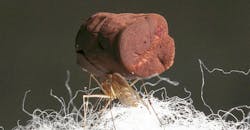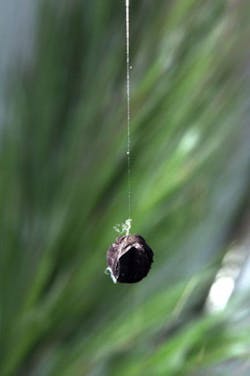After more than 10 years of research, scientists at Lawrence Livermore National Lab created ultra-low-density metal foams so they would have better X-ray sources for fusion experiments at the National Ignition Facility (NIS).
The metals are configured as foams, but they’re not made by foaming. They are a spaghetti-like web of randomly connected nanometer-sized wires formed into the shape of a miniature marshmallow and containing the same or fewer number of atoms as air.
Scientists created these ultra-low-density metals so they could be used as targets for laser-driven X-rays in experiments on the properties of materials in extreme situations, i.e., when NIF’s 192 high-powered lasers are firing at them.
Each element emits a characteristic set of X-rays when heated by such lasers and get turned into a plasma. Metal foams mimic gasses even though they are made from materials that are solid at room temperature.
The underlying physics of laser-driven X-ray sources, however, means there are rigorous specifications for the types, densities, shapes, and sizes of metal foams needed for targets experiments; they must be around the density of air and a few millimeters in size within well-defined dimensions.
An ultra-low-density metal foam sample dangles from a strand of a spider’s web.
The team also had to make sure the techniques they developed could be repeated to consistently produce the foams, even if the size, shape, and composition are changed for future experiments. They need to make either the same material or a comparable one every time, and understand how any change will affect the final target material.
Over the years failed efforts included ones that had to be aged in air before they could be brought into the target chamber, and then they ended up looking like “old, stale marshmallows.” Another iteration came out of molds looking distorted, and others fell apart so easily one team member called them “cigarette ash.”
The team also tried using scaffolding built out of other low-density materials to support particles of the target metals. But the scaffolding materials would create unwanted X-rays when hit by lasers and interfere with the data scientists wanted.
So, to maintain the purity of the X-ray spectrum, the team had to create the wire structures out of the specific metals.
The team freezes the nanowire inside a mold typically filled with a water-glycerol mix. When it hardens, the nanowire looks like a randomly interconnected mesh of frozen spaghetti.
The material is removed from the mold and the frozen water is extracted by replacing it with acetone, a solvent, which is then dissolved in a supercritical drying process using liquid carbon dioxide, leaving only the metal and air. Supercritical drying ensures the liquid transforms into a gas without creating a meniscus that could damage the fragile ultra-low density metal foam.
The team has produced copper and silver foam, and silver has performed particularly well in NIF shots. The team can also make gold foams, but they still tend to fall off the mounts that hold them in front of NIF’s lasers. That’s a challenge the team is currently trying to overcome.
Foam metals could also be useful as target shells or hohlraum liners. And now that scientists know the material can be made, it could spur creative ideas for future experiments.


